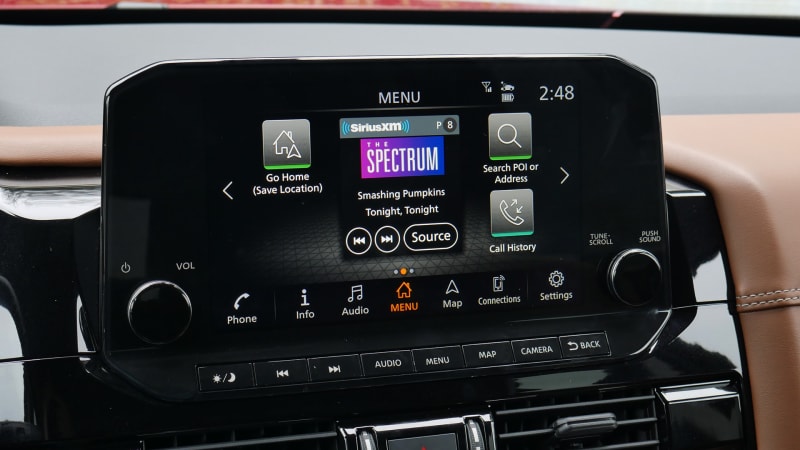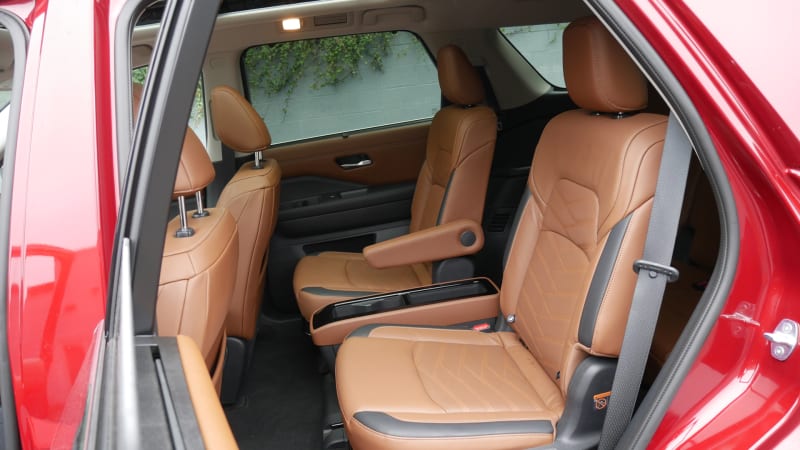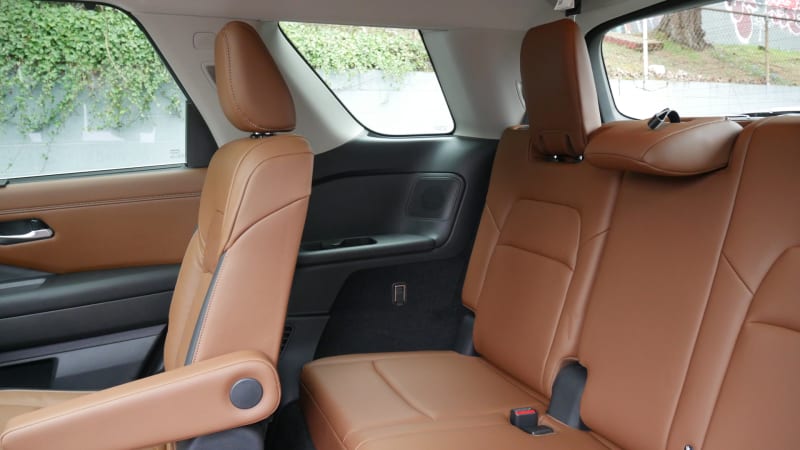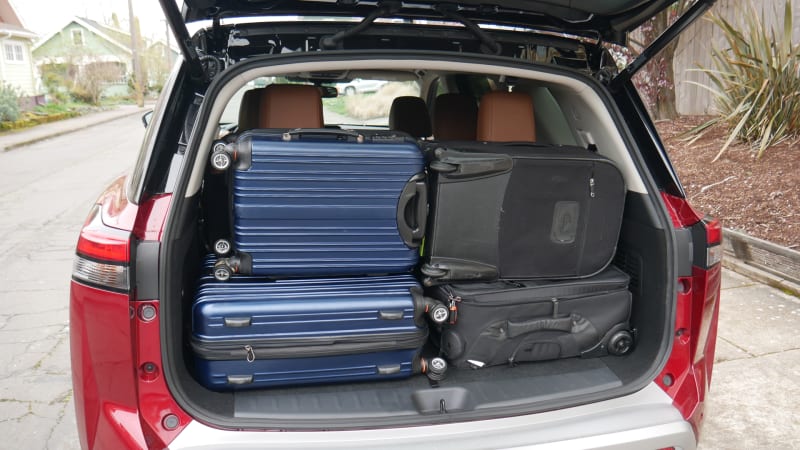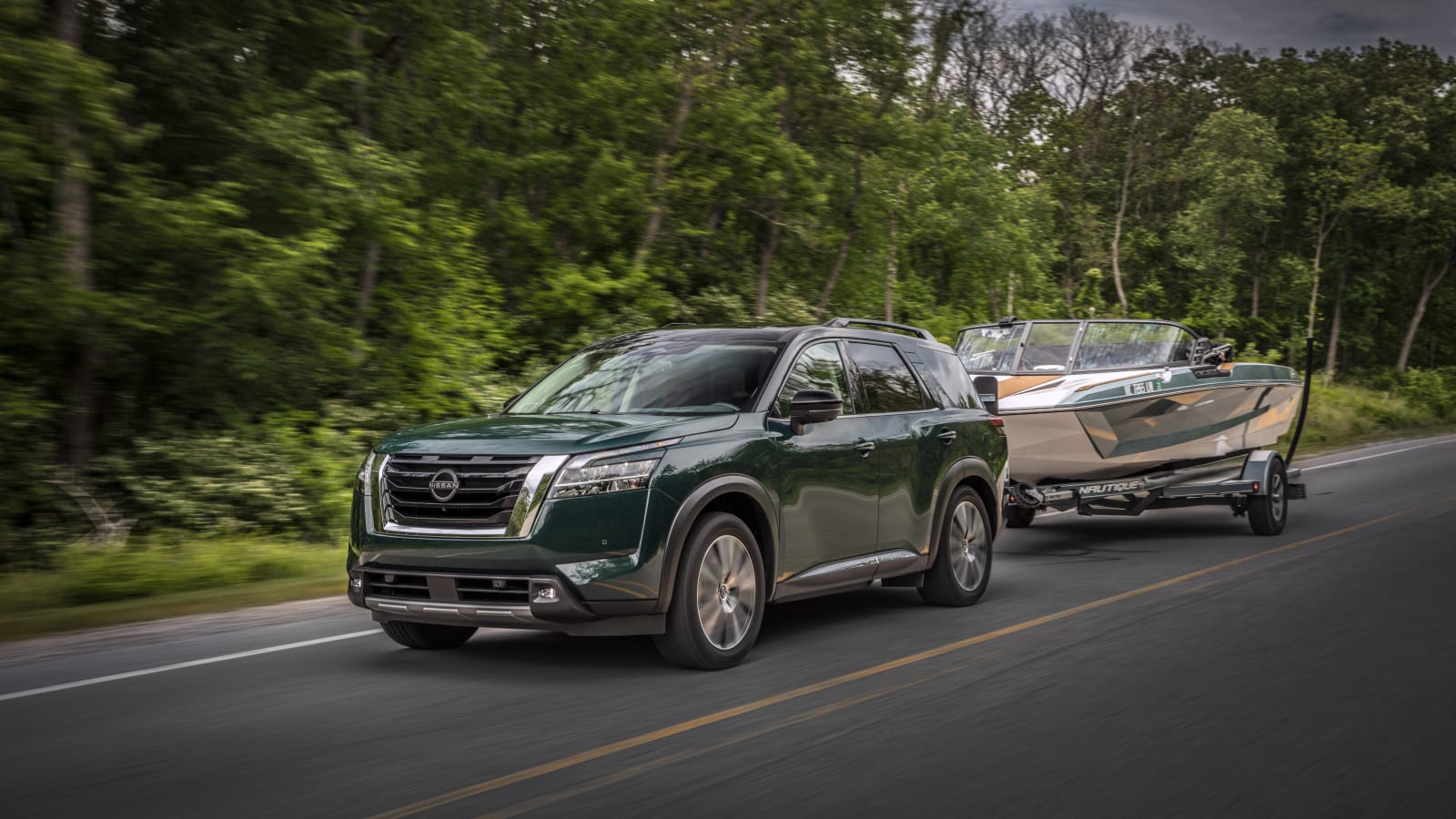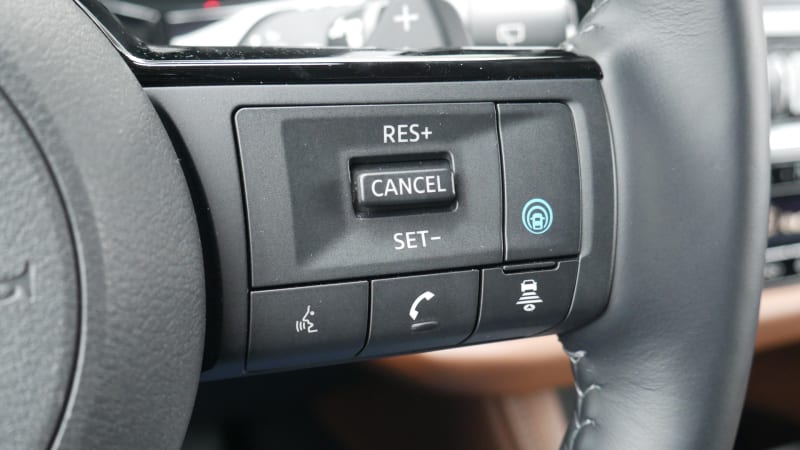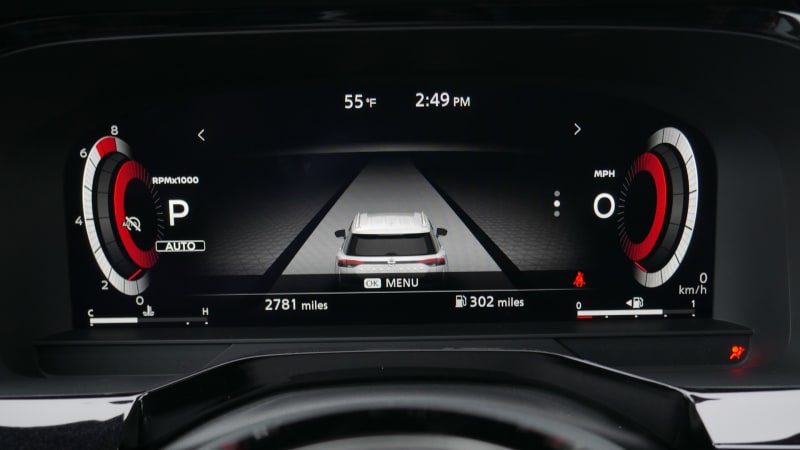The 2022 Nissan Pathfinder may possess one of the oldest SUV nameplates, but the actual vehicle itself has changed wildly over the years. It has oscillated between body-on-frame and unibody (crossover) architecture, and has grown in size and seat number. It’s been a vehicle actually capable of finding paths and one that’s better suited to using well-paved paths already found. Now, the Pathfinder has been redesigned again and for the first time in the nameplate’s 37-year existence, it’s maintaining its architecture and seat count from one generation to the next.
The 2022 Pathfinder is still a seven-passenger crossover, and although it continues to fall into “paths already found” camp, its bolder, more chiseled appearance is at least more in keeping with Pathfinders of old. Its interior is more modern in appearance, materials quality and technology content – it’s even one of the best in the segment in that regard. Interior space is obviously ample considering it’s a three-row SUV, but it’s also merely average in terms of third-row and cargo space. The driving experience has also been dramatically improved from its rather unfortunate predecessor, with the highlight being a new nine-speed automatic replacing the old CVT. It still isn’t our top pick in the segment, but we’re also no longer put off.
In short, the new Pathfinder is more in keeping with the nameplate’s first three generations in vibe, if still totally different in concept and engineering. That makes it a more appealing and slightly better family hauler. We’d still choose a Kia Telluride, Hyundai Palisade, Toyota Highlander Hybrid or Jeep Grand Cherokee L first, but among the second tier of alternatives, the Pathfinder should definitely be considered.
Interior & Technology | Passenger & Cargo Space | Performance & Fuel Economy
What it’s like to drive | Pricing & Features | Crash Ratings & Safety Features
What’s new for 2022?
The Pathfinder isn’t quite “all-new.” Despite the preceding generation lasting much longer than usual, its underlying platform and 3.5-liter V6 carry over. Think about it as the bones being the same, but it gets totally new skin and clothing. You can read more about what’s new in our 2022 Nissan Pathfinder first drive.
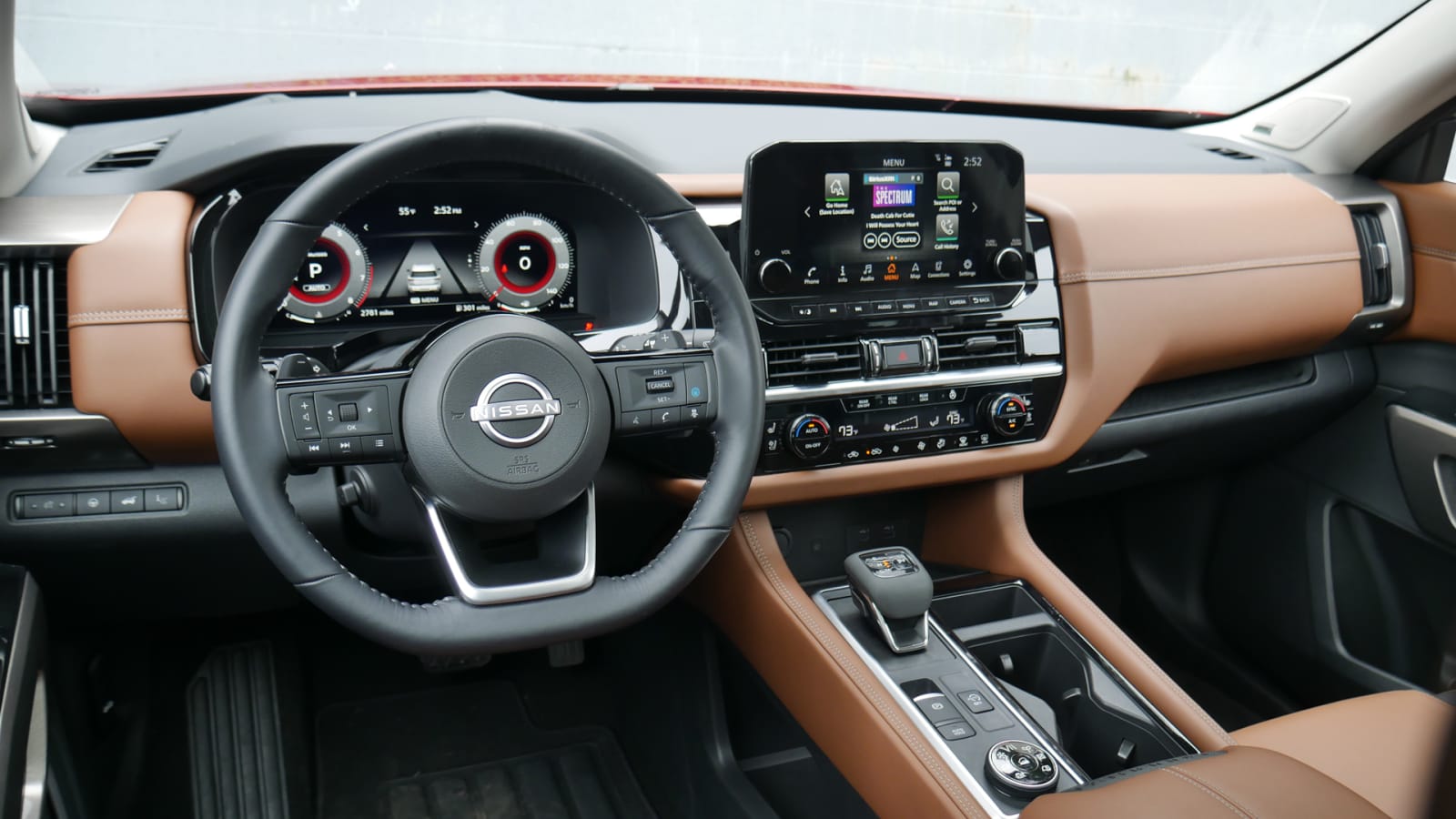
What are the Pathfinder interior and in-car technology like?
This is arguably the Pathfinder’s best attribute. Although the range-topping Platinum trim level you see up there is its best foot forward, complete with handsome two-tone leather/pleather all over the place, even lower trim levels benefit from the same handsome design, thoughtful storage and user-friendly technology. General materials quality is average for the segment, which speaks to how good the segment is.
The center console features a vast pad to charge your smartphone, be it wired or wireless on upper trims, plus a smaller bin to prop up your phone should you prefer. The cupholders are big and versatile, the under-armrest and door bins are large, and there’s bonus storage under the console. You can also get a fixed center console in between the available second-row captain’s chairs, but it’s wide open, which isn’t great for security or accumulating Cheerios.
The 9-inch touchscreen you see here is standard on the SL and Platinum trim levels, and features a user interface that really nails a sweet spot of aesthetics and functionality. There are hard buttons and knobs, plus a stationary row of on-screen menu icons, which are always appreciated. The display itself is high resolution and features vibrant colors with attractive, legible graphics. It may not be ultra-wide (as in the Palisade and Telluride) or tall (Explorer), but it’s big enough, easy to see and works well. We have not sampled the 8-inch screen found in the S and SV trims, but we would assume based on such screens in other Nissans that its user-friendly functionality should be roughly the same despite the smaller size.
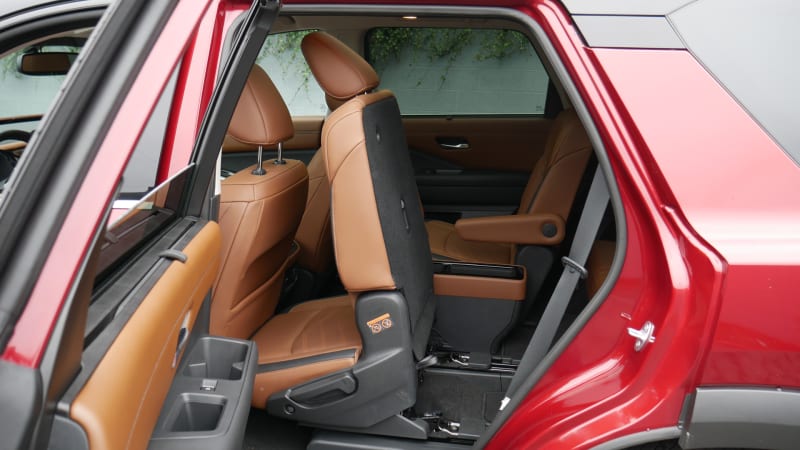
How big is the Pathfinder?
The 2022 Pathfinder is basically the same size on the outside as the Palisade, Telluride, Pilot, Subaru Ascent, etc. Differences inside are more noticeable, however, particularly in the third row where the seat is a little closer to the floor than you’d find in those mentioned above and therefore less spacious and comfortable. Nissan’s means of getting back there is better than most, however, as the second-row not only slides forward at the touch of a button (that’s quite common), but does so in a way that provides more space to squeeze back into the third-row and allows you to keep forward-facing child seats installed. That could easily be deal-sealer for some and might actually be necessary if you opt for the Platinum and its fixed center console.
Cargo space behind the raised third row measures at 16.6 cubic-feet, which is basically the same as the Honda Pilot, but like that competitor, the Pathfinder’s boxy shape and useful under-floor storage actually help it carry more stuff than its specs would indicate. We could fit four medium-sized suitcases back there plus a duffle bag under the floor. It measures 45 cubic-feet with the third row lowered and 80.5 with both rear rows lowered, which are big enough that differences with competitors shouldn’t matter much.
What are the Pathfinder fuel economy and performance specs?
Like more competitors, there is only one engine on offer: a 3.5-liter V6 good for a competitive 284 horsepower and 259 pound-feet of torque. It is paired to a nine-speed automatic, and either standard front-wheel drive or optional all-wheel drive. Fuel economy is 21 mpg city, 26 mpg highway and 23 mpg combined with FWD. Surprisingly, AWD fuel economy is actually better on the highway, but effectively the same: 21/27/23. The Platinum AWD trim goes down to 20/25/22. All these figures are typical for the segment.
With the available tow hitch, the Pathfinder can tow 6,000 pounds, which is more than the segment’s 5,000-pound norm.
What’s the Pathfinder like to drive?
We thankfully no longer have to gripe about a CVT mooing on as the Pathfinder chugs up a highway on-ramp – the new nine-speed automatic does its job commendably enough that we didn’t really notice it. The same can largely be said of the 284-hp V6, which is sufficiently strong for the segment but hardly a standout for better or worse.
The new Pathfinder is notably more composed than its predecessor, which was a bit squishy and prone to bobbing over bigger bumps. Its steering is also better weighted. Still, the steering effort and response never feels quite right – perhaps a tad too slow given the amount of effort – and the suspension with the available 20-inch wheels produces an usual ride that combines a firm response to harsher impacts with a relaxed response to larger bumps and undulations. You get the impression Nissan didn’t quite know which lane to choose, so to speak, while tuning the Pathfinder. Its competitors are more coherent.
What other Nissan Pathfinder reviews can I read?
2022 Nissan Pathfinder First Drive Review | Automatically better; still not the best
Read this for more information about all that changed for 2022, plus a deeper dive into what it’s like to drive.
How much is the 2022 Pathfinder price?
Pricing for the 2022 Pathfinder starts at $36,330 for the base S trim level, including the $1,225 destination charge. All-wheel drive is a $1,900 option on all trim levels.
You can find feature content for each of the Pathfinder trim levels here on Autoblog.
S: $36,330
SV: $37,895
SL: $41,365
Platinum: $47,965
What are the Pathfinder safety ratings and driver assistance features?
Every 2022 Pathfinder includes forward collision warning with automatic emergency braking that detects pedestrians and cyclists; rear automatic braking (a rare feature); blind-spot and rear cross-traffic warning (usually optional); and lane-departure warning. Steering intervention for the blind-spot and lane-departure system is added on all but the base S. The top three trims also have Nissan ProPilot Assist, the advanced adaptive cruise control system that adds well-executed steering assist system. You have to keep a hand on the wheel, but the car does most of the work.
NHTSA had not crash tested the 2022 Pathfinder at the time of this writing. The Insurance Institute for Highway Safety gave it the best-possible score of “Good” in all crash tests, but curiously, it got a second-best “Acceptable” score for its head restraints and seats. We honestly don’t remember seeing a car get something other than “Good” before in that category. The Pathfinder also got an “Acceptable” score for its headlights, which is actually pretty good for the industry, and top marks for its forward collision prevention systems.
Related Video:
Source: www.autoblog.com

